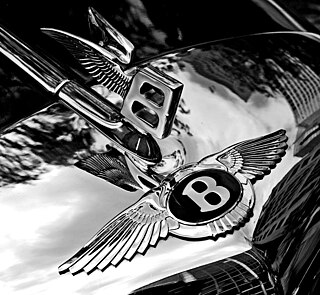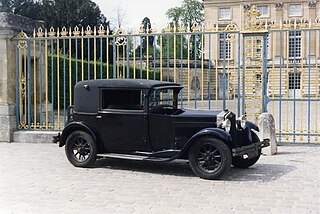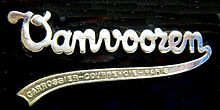
Bentley Motors Limited is a British designer, manufacturer and marketer of luxury cars and SUVs. Headquartered in Crewe, England, the company was founded by W. O. Bentley (1888–1971) in 1919 in Cricklewood, North London, and became widely known for winning the 24 Hours of Le Mans in 1924, 1927, 1928, 1929 and 1930. Bentley has been a subsidiary of the Volkswagen Group since 1998 and consolidated under VW's premium brand arm Audi since 2022.

Vanden Plas is the name of coachbuilders who produced bodies for specialist and up-market automobile manufacturers. Latterly the name became a top-end luxury model designation for cars from subsidiaries of British Leyland and the Rover Group, it was last used in 2009 to denote the top-luxury version of the Jaguar XJ (X350).

Hispano-Suiza is a Spanish automotive company. It was founded in 1904 by Marc Birkigt and Damián Mateu as an automobile manufacturer and eventually had several factories in Spain and France that produced luxury cars, aircraft engines, trucks and weapons.

A coachbuilder or body-maker is a person or company who manufactures bodies for passenger-carrying vehicles. Coachwork is the body of an automobile, bus, horse-drawn carriage, or railway carriage. The word "coach" was derived from the Hungarian town of Kocs. A vehicle body constructed by a coachbuilder may be called a "coachbuilt body" or "custom body".

The Rolls-Royce Phantom IV is a British automobile produced by Rolls-Royce. Only eighteen were made between 1950 and 1956, sold only to buyers whom Rolls-Royce considered worthy of the distinction: the British royal family and heads of state. Sixteen are known to still exist in museums as well as in public and private collections.

The Bentley Mark V was Rolls-Royce's second Bentley model. Intended for announcement at the Earl's Court Motor Show set down for late October 1939 it had much in common with its predecessor. War was declared on 3 September 1939 and a few days later Bentley announced it had ceased production of civilian items.
Park Ward was a British coachbuilder founded in 1919 which operated from Willesden in North London. In the 1930s, backed by Rolls-Royce Limited, it made technical advances which enabled the building of all-steel bodies to Rolls-Royce's high standards. Bought by Rolls-Royce in 1939, it merged with H. J. Mulliner & Co. in 1961 to form Mulliner Park Ward.

The Rolls-Royce Wraith was built by Rolls-Royce at their Derby factory from 1938 to 1939 and supplied to independent coachbuilders as a rolling chassis.
Carrosserie Hibbard et Darrin was a French coachbuilder located 12 Rue de Berri in Paris, just off the Champs-Élysées. Owned by two Americans, Hibbard and Darrin, it built bodies for various luxury car chassis, including Rolls-Royce, Duesenberg and Minerva.

Georges Paulin was a French Jewish dentist, acclaimed and inventive automobile designer and coachwork stylist, and died as a hero of the French Resistance during World War II.

Carrosserie Pourtout was a French coachbuilding company. Founded by Marcel Pourtout in 1925, the firm is best known for its work in the decades prior to World War II, when it created distinctive and prestigious bodies for cars from numerous European manufacturers. Pre-war Pourtout bodies were mainly one-off, bespoke creations, typically aerodynamic and sporting in character. Together with chief coach designer and stylist Georges Paulin from 1933 to 1938, Pourtout pioneered the Paulin invented 'Eclipse' retractable hardtop system on four models of Peugeot, several Lancia Belna's and other car makes.
Among the company's customers was Georges Clemenceau, the physician and journalist who served as the prime minister of France from 1906 to 1909 and 1917 to 1920.

The Hispano-Suiza J12 is a luxury automobile that was made by Hispano-Suiza in France from 1931 to 1938. It was the largest and most expensive car ever built by Hispano-Suiza. It replaced the Hispano-Suiza H6. The J12 was only available as a chassis, buyers having to arrange with an outside coachbuilder to integrate a body.

Weymann Fabric Bodies is a patented design system for fuselages for aircraft and superlight coachwork for motor vehicles. The system used a patent-jointed wood frame covered in fabric. It was popular on cars from the 1920s until the early 1930s as it reduced the usual squeaks and rattles of coachbuilt bodies by its use of flexible joints between body timbers.

Saoutchik was a French coachbuilding company founded in 1906 and based in Neuilly-sur-Seine near Paris. The company was one of the best-known coachbuilders in France in the 1920s and 1930s and, together with Figoni et Falaschi and Franay, is considered one of the most important representatives of the "Baroque" style in French coachwork in the 1930s and 1940s.

J Gurney Nutting & Co Limited was an English firm of bespoke coachbuilders specialising in sporting bodies founded in 1918 as a new enterprise by a Croydon firm of builders and joiners of the same name. The senior partner was John (Jack) Gurney Nutting (1871–1946).

Jarvis & Sons Limited were South London-based motor dealers for Morris and MG, and latterly coachworks providing special bodies for various car chassis until after World War II.

Corsica Coachworks was a small British coachbuilding business founded in 1920 just after World War I. They were builders of bespoke car bodies, employing no in-house designer. They realised customers' designs for them. Almost every Corsica body is unique.
Franay was a French coachbuilder operating at Levallois-Perret, a suburb on the prosperous north-western edge of Paris. The company was founded in 1903 by Jean-Baptiste Franay, a carriage upholsterer, following an apprenticeship with Binder. It was later taken over by his son, Marius. Franay car body production stopped in late 1955.

The Hispano-Suiza H6B Dubonnet Xenia is a one-off luxury car made by Spanish automobile manufacturer Hispano-Suiza for French pilot and racing car driver André Dubonnet in 1938. The car was built on the chassis of the Hispano-Suiza H6B, however it uses the larger, more powerful engine from the H6C and an entirely new body design drawn by Jean Édouard Andreau and built by coachbuilder Saoutchik.
Antem Carrossier was a French coachbuilding company that, in the period between the world wars and a short time afterwards, produced one-off bodies for luxury car chassis, as well as some bodies in small series production.
























